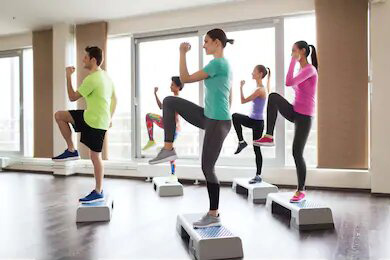Aerobic and eight
sports misunderstandings, Aerobic exercise is
related to the physiological process of the body's energy supply, and the whole
process is carried out in the cell. The absorbed sugar is gradually decomposed
and finally turned into water and carbon dioxide. If you
want to completely break down the sugar in the cell, you need to have a
sufficient supply of oxygen for a period of time. The most energy can be
extracted from these sugars to cope with the body's needs. This metabolic
process that requires oxygen is called "aerobic metabolism." The
body's energy supply mainly has two metabolic procedures, one is
"aerobic" and the other is "anaerobic."
Aerobic and Eight Sports Misunderstandings
A
large family of
Aerobic and eight
sports misunderstandings, Aerobics is a
general term for a large group of sports that provide the body's energy supply
and process through aerobic metabolism. As long as the nature of the
exercise takes a long time, and the load of each movement does not require
great strength, it can be summarized as aerobic exercise. For example,
slow running, fitness dance, swimming, walking, walking, etc. are typical
aerobic exercises. And some sports that require a lot of explosive power are called
anaerobic exercise, such as weightlifting, sprinting and the like.
The
benefits of proper exercise
Are different for each
activity, but they all provide good exercise for cardiopulmonary function, and
they are safe and easy to adjust to various load levels to suit individual
abilities, so it is good. Health care is also very useful for improving
physical fitness.
Crack the eight common sports misunderstandings
Aerobic and eight
sports misunderstandings, Exercise is good for the
body, but it takes a lot of effort to exercise properly and get it done,
otherwise it can lead to injury. Below, we clarify the eight
misunderstandings of the movement for everyone; I hope everyone will pay
attention to it.
Misunderstanding
1: You can't do any warm-up exercises before
exercise.
The purpose of warm-up
is to stimulate the brain and prepare the body for a higher-intensity
exercise. Warm-up can avoid straining your muscles by sudden force during
exercise. Many other injuries can also be prevented by proper warm-up
exercises. Therefore, warm-up exercises before and after exercises are
equally important.
Myth
2: Eat more red meat before exercise to promote
muscle growth.
Meat contains a lot of
protein, but it doesn't replenish energy
quickly. The ideal food before exercise is high-carbohydrate
carbohydrates (such as pasta and bread). In
addition, the pre-exercise diet is not as important as imagining, because the
energy needed for today's exercise is based on yesterday's diet.
Myth
3: To achieve the best results, you must exercise
every hour, seven days a week.
In fact, as long as we
exercise consistently, even a few dozen minutes every day can be very
energetic. Studies have shown that two to three times a week, half an hour
of simple exercise, such as slow running, healthy dance, etc., can
significantly reduce the incidence of heart disease, lower blood pressure,
relieve stress and enhance energy and immunity. On the contrary, excessive
exercise can easily lead to physical trauma.
Myth
4: Running is the best way to exercise.
The best fitness
methods vary from person to person, so there is no absolute fitness
method. One person's medicine can be another person's arsenic. Fitness exercises should
be "fit" rather than "best". The "best"
method often has the meaning of getting the fastest results, but fitness needs
to be consistent and patience.
Myth
5: The best exercise time is in the early morning.
The best workout time
is when you have the desire to exercise and match your schedule. Some
people like to exercise in the morning, and some people like to exercise in the
evening. The most important thing is to find the most suitable and convenient
time. In fact, no matter what time you exercise, it is not a problem,
because you will benefit from it.
Misunderstanding
6: The more painful you feel during exercise, the
greater the effectiveness of fitness.
Pain is actually a sign of
physical discomfort. When you feel pain during exercise, you should
try to reduce and slow down the exercise as much as possible, and then stop
slowly. If you continue to do so, you may get hurt.
Myth
7: Exercising the same part of the body every day can
speed up the strength of the part.
The same part of your
body every day will only speed up the damage. To increase strength, you
should train your muscles to the most tired point, and then give the muscles of
this part a rest and recovery from day to day. Excessive exercise can only
cause muscle strain and pain, and the effect is counterproductive.
Misunderstanding
8: Hot compress can make the damage faster.
The pain of sports
injuries (such as an ankle sprain) is due to bleeding and swelling in the
wound. Hot compresses only accelerate blood circulation, speed up bleeding
and make swelling more serious. The correct treatment is to apply cold
(such as ice and ice water) within 24 hours of injury, and use heat therapy to relieve
pain and swelling after 24 hours.
Click
here for more interesting articles.






